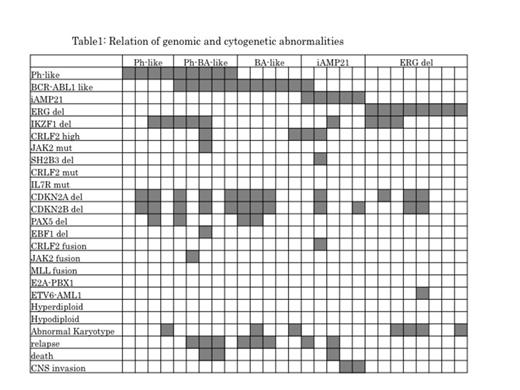Abstract
Introduction; Acute lymphoblastic leukemia (ALL) is the most common cancer in children. Most childhood cases of B-precursor ALL (BCP-ALL) may be subclassified by the presence of either gross or submicroscopic genetic alteration. Recent genomewide analyses have identified genetic or cytogenetic subtypes, such as Ph-like ALL, deletion of ERG, intrachromosomal amplification of chromosome 21 (iAMP21) in BCP-ALL. Deletion of ERG and iAMP21 were associated with frequent IKZF1 deletions, which were found in Ph-like ALL associated with poor prognosis. However, the frequency and prognostic implications of these genomic abnormalities have not been defined in Japan.
Patients and Methods; We studied 208 children with de novo BCP-ALL enrolled on Tokyo Children Cancer Study Group (TCCSG) ALL L0416 and L0616 trials. All patients had a diagnosis of BCP-ALL without BCR-ABL1 phenotype confirmed by morphology, immunophenotyping and mRNA Real-time PCR. Alterations of ERG and iAMP21 were examined by Multiplex Ligation-dependent Probe Amplification (MLPA) kit P327-B1. To identify Ph-like ALL and BCR-ABL1 like ALL, We investigated gene expression of 235 BCP-ALL cases enrolled on TCCSG L0416 and L0616 trials by microarray GeneChip Human Genome U133 Plus 2.0 and analyzed using clustering analysis as described previously. To assess whether these genomic alterations overlap with known gene abnormalities, such as mutations of CRLF2,JAK1, JAK2 and IL7R, rearrangement of P2RY8-CRLF2, PAX5-JAK2 and PDGFRB-EBF1 genes and copy number alteration of IKZF1, CDKN2A/2B, PAX5, EBF1 and SH2B3 genes, mutational analyses of these genes were also performed using direct sequencing, RT-PCR or MLPA kit P335-A1 and P200.
Results; We identified Ph-like signature in 9 (3.8%) patients and BCR-ABL1 like ALL signature in 11 (4.7%) patients. Five (55.6%) of 9 Ph-like ALL patients and 3 (27.3%) of 11 BCR-ABL1 like ALL patients have IKZF1 deletions. Five patients were classified into both Ph-like ALL and BCR-ABL1 like ALL. Among these 5 patients, one patient had CRLF2 high expression, JAK2 R683S/R683G mutation, CDKN2A/2B deletion and EBF1 deletion, and another patient have PAX5-JAK2 rearrangement. These two patients relapsed, and the latter patient died. Three of 9 Ph-like ALL patients relapsed and 2 died, while 7 of 11 BCR-ABL1 like ALL patients relapsed and 2 died. We identified iAMP21 in 5 (2.4%) patients and deletion of ERG in 8 (3.8%). One of 5 patients with iAMP21 and 3 of 8 patients with ERG deletion had IKZF1 deletion. One patient with iAMP21 had BCR-ABL1 like ALL signature, but not Ph-like ALL signature. CRLF2 high expression was identified in two of 5 patients with iAMP21, and P2RY8-CRLF2 rearrangement and SH2B3 deletion was identified in one of them. No mutations of CRLF2 and JAK2 were identified in patients with iAMP21 and ERG deletion. Among 5 iAMP21 patients, patient with BCR-ALB1 signature and IKZF1 deletion relapsed, and one patient died. No patients with ERG deletion relapsed or died.
Conclusions; Using GeneChip microarray analysis, low frequency of Ph-like ALL signature and BCR-ABL1 like ALL signature was found. Using MLPA as a novel screenings technique, frequency of iAMP21 and ERG deletion in pediatric BCP-ALL was similar to that of previous studies. BCR-ABL1 like ALL and iAMP21 was associated poor prognosis, while ERG deletion was associated good prognosis in pediatric ALL. These data suggest that screening for these genetic abnormalities in pediatric patients with BCP-ALL is critical not only for outcome prediction but also for risk-adapted therapy.
No relevant conflicts of interest to declare.
Author notes
Asterisk with author names denotes non-ASH members.


